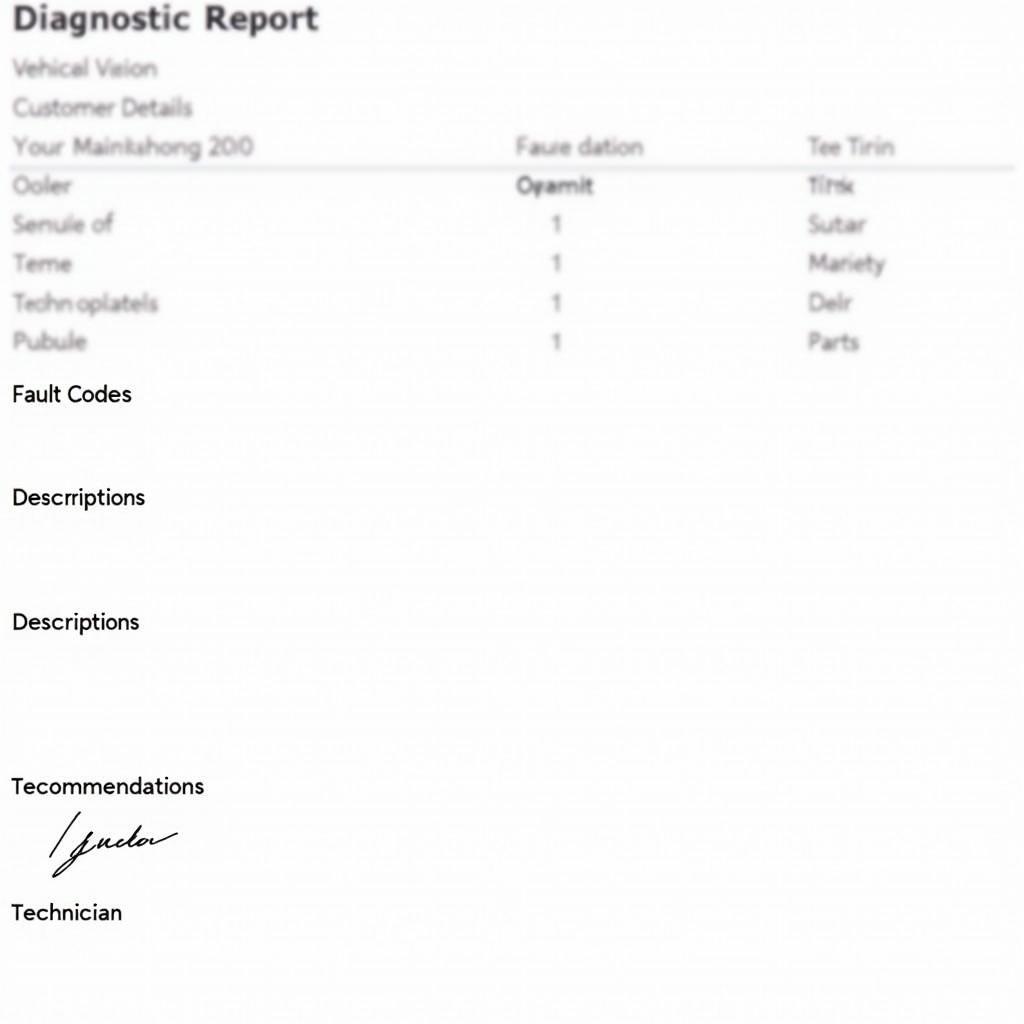A Car Diagnostic Report Template is a standardized document used by automotive technicians to record the findings of a vehicle diagnostic scan. This report provides a detailed snapshot of your car’s health, pinpointing potential issues and offering insights into their severity. Think of it as a medical report for your car, offering valuable information to guide repair decisions and ensure optimal vehicle performance.
Why is a Car Diagnostic Report Template Important?
 Sample Car Diagnostic Report
Sample Car Diagnostic Report
A car diagnostic report template plays a crucial role in the automotive repair process. Here’s why:
- Accurate Diagnosis: The template ensures a systematic approach to analyzing the data from a diagnostic scan, minimizing the risk of overlooking potential problems.
- Clear Communication: It facilitates transparent communication between technicians and car owners by presenting complex technical information in an easy-to-understand format.
- Informed Decision Making: Car owners can use the report to understand the urgency of repairs, compare quotes from different mechanics, and make informed decisions about their vehicle’s maintenance.
- Documentation and History: The report serves as a valuable record of your car’s repair history, which can be helpful for future diagnostics, warranty claims, and even resale value.
Key Components of a Car Diagnostic Report Template
A comprehensive car diagnostic report template typically includes the following sections:
-
Vehicle Information: This section identifies the vehicle being diagnosed, including the make, model, year, VIN (Vehicle Identification Number), and mileage.
-
Customer Information: This section records the car owner’s details, including name, contact information, and any specific concerns they have reported.
-
Fault Codes: This is the heart of the report, listing all the Diagnostic Trouble Codes (DTCs) retrieved from the vehicle’s onboard computer.
-
Fault Code Descriptions: Each DTC is accompanied by a concise description explaining the potential problem area within the vehicle system.
-
Recommendations: Based on the fault codes and their descriptions, the technician provides recommendations for further inspection, repair, or replacement of specific components.
-
Additional Findings: This section allows the technician to include any observations or findings from a visual inspection of the vehicle that may not be directly reflected in the fault codes.
-
Parts and Labor Estimates: A breakdown of the estimated costs for parts and labor required to address the identified issues is often included.
-
Technician Information: The report typically concludes with the diagnosing technician’s name, signature, and contact information.
How to Interpret a Car Diagnostic Report Template
While a car diagnostic report template provides valuable information, understanding the technical jargon can be challenging for car owners. Here’s a simplified guide:
- Focus on the Fault Code Descriptions: Pay close attention to the plain-language descriptions of each fault code, as they provide insights into the potential problem areas.
- Prioritize Recommendations: The technician’s recommendations should be your primary guide for taking further action. They outline the necessary steps to address the identified issues.
- Ask Questions: Don’t hesitate to clarify any doubts or ask for further explanation from your mechanic. A good technician will be happy to explain the report in detail and address your concerns.
Car Diagnostic Report Templates: A Tool for Transparency and Trust
“Car diagnostic report templates are essential for building trust and transparency in the automotive repair industry,” says John Smith, Senior Automotive Technician at XYZ Auto Services. “These reports empower car owners with the knowledge they need to make informed decisions about their vehicle’s maintenance.”
By providing a standardized format for communicating diagnostic findings, these templates help bridge the information gap between technicians and car owners, fostering a more collaborative and trustworthy repair experience.
Conclusion
A car diagnostic report template is an indispensable tool in the world of automotive repair. It provides a clear and concise overview of your vehicle’s health, enabling informed decision-making and ensuring optimal vehicle performance. By understanding the key components and learning to interpret the information, car owners can proactively address potential issues and keep their vehicles running smoothly.
FAQs
1. How often should I get a car diagnostic scan?
It’s generally recommended to have your car diagnosed annually or whenever your check engine light illuminates.
2. Can I perform a car diagnostic scan myself?
Yes, affordable OBD-II scanners are available for DIY enthusiasts. However, consulting a qualified mechanic is advised for a comprehensive diagnosis.
3. Are all car diagnostic report templates the same?
While the core components are similar, the format and level of detail may vary depending on the software and the mechanic’s preferences.
4. Does a car diagnostic report guarantee a specific problem?
No, it highlights potential issues. Further inspection by a qualified technician is necessary to confirm the diagnosis and recommend repairs.
5. Can a car diagnostic report help with warranty claims?
Yes, a documented history of diagnostic reports can be valuable supporting evidence for warranty claims related to specific components.
Need expert assistance with car diagnostics? Contact us on WhatsApp: +1(641)206-8880, Email: [email protected]. Our dedicated team is available 24/7 to provide support.

Leave a Reply